
Thera variata, the spruce carpet, is a moth of the family Geometridae. It is found throughout Europe, North Asia and Japan. The common name spruce carpet is also used when referring to Thera britannica.

Mesapamea secalis, the common rustic, is a moth of the family Noctuidae. The species was first described by Carl Linnaeus in his 1758 10th edition of Systema Naturae. It is found in Europe, north-west Africa, Turkey and northern Iran.
Xyroptila peltastes is a moth of the family Pterophoridae. It is found in Australia.

Hexadactilia trilobata is a moth of the family Pterophoridae described by Thomas Bainbrigge Fletcher in 1910. It is found in Australia in Queensland and New Guinea.
Batrachedra trimeris is a species of moth of the family Batrachedridae. It is found in Australia.
Ypsolopha walsinghamiella is a moth of the family Ypsolophidae. It is known from the United States, including Arizona and California.
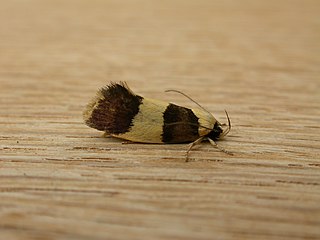
Telecrates laetiorella is a moth of the family Xyloryctidae. It is known from the Australian Capital Territory, New South Wales, Queensland, South Australia and Victoria.
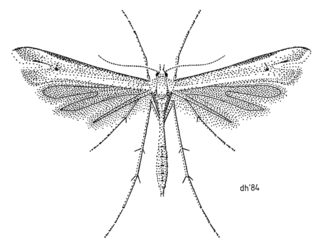
Amblyptilia lithoxesta is a moth of the family Pterophoridae. It is endemic to New Zealand. It was first described by Edward Meyrick in 1885. This species inhabits rough herbage on mountain sides. Larvae feed on Veronica buchananii. Adults are on the wing in January.

Ichneutica steropastis, or the flax notcher moth, is a species of moth in the family Noctuidae. It is endemic to New Zealand and can be found throughout the country from the Three Kings Islands to Stewart Island as well as in the Chatham Islands. The larvae of this species feed on a variety of native and introduced plants however the New Zealand flax is one of the more well known host plants for the larvae of this moth. The larvae are nocturnal, hiding away in the base of the plants and coming out to feed at night. They create a distinctive notch in the leaf when they feed. The adults of this species are on the wing from October to March. Although adult specimens of I. steropastis are relatively easy to recognise they might possibly be confused with I. inscripta, I. theobroma or with darker forms of I. arotis. However I. steropastis can be distinguished as it has a long dark basal forewing streak that these three species lack.

Rhigognostis senilella, the rock-cress smudge, is a moth of the family Plutellidae. It is found in Iceland, Ireland, Great Britain, France, Germany, Denmark, Austria, Switzerland, Italy, the Czech Republic, Slovakia, Serbia, Hungary, Poland, Norway, Sweden, Finland, Latvia, Russia and on Sardinia. Outside of Europe, the range extends to the Caucasus, Central Asia and Japan. It is also found on Greenland. The habitat consists of rocky areas such as coastal or mountain areas.
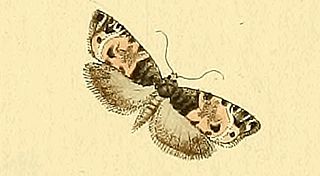
Notocelia incarnatana, the chalk rose bell, is a species of moth of the family Tortricidae. It is found in China, Mongolia, Japan, Russia, Kazakhstan and Europe, where it has been recorded from most of the continent, except parts of the Balkan Peninsula.

Pyrgotis eudorana is a species of moth of the family Tortricidae. It is endemic in New Zealand and has been observed in both the North and South Islands. However it is regarded as a rare insect. This species inhabits native forest. Larvae exclusively feed on Muehlenbeckia australis and adults are on the wing from November to April. Adults are attracted to light.

Pyrgotis plinthoglypta is a species of moth of the family Tortricidae. It is endemic to New Zealand and is found throughout the whole country. The preferred habitat of this species is native forest. The larvae of this species feeds on rimu leaves from under a silken web. It pupates in loose cocoons amongst rimu foliage. Adults are on the wing from October to May and are night flying. They are attracted to light and can be collected by beating their host tree. The adult insect resembles a small dried fragment of rimu foliage when at rest.
Helcystogramma septella is a moth in the family Gelechiidae. It was described by Philipp Christoph Zeller in 1852. It is found in Malawi, South Africa, Tanzania and the Gambia.
Stenoma recondita is a species of moth of the family Depressariidae. It is found in Guyana.
Antaeotricha bicolor is a species of moth of the family Depressariidae. It is found in Brazil.
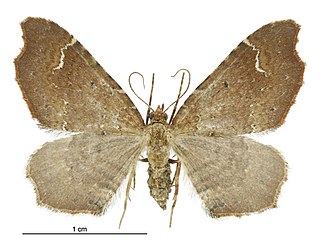
Asaphodes camelias is a species of moth in the family Geometridae. It is endemic to New Zealand, has been observed in both the North and South Islands and inhabits native forest. The adults of this species are on the wing from February to May and July to September.

Ichneutica paracausta is a moth of the family Noctuidae. This species is endemic to New Zealand. It is found locally in the central North Island, is widespread in the South Island and can also be found in Stewart Island. I. paracausta is variable in colour, but as it has a distinctive black streak on its forewing as well as a wing pattern that is characteristic, I. paracausta is unlikely to be confused with other species. It is present on the North Island volcanic plateau as well as Little Bush Reserve in Hawkes Bay in the North Island as well as in tussock grassland, alpine and subalpine shrubland and in alpine forest. Larvae have been recorded as feeding on grasses, a pupa has been found in a cocoon under the bark of a tree and adult moths are on the wing from October to January.

Tingena ancogramma is a species of moth in the family Oecophoridae. It is endemic to New Zealand and has been found in the Hen and Chicken Islands, the North Island and the South Island. Adults are on the wing in summer and autumn and inhabit open areas of forest scrubland.
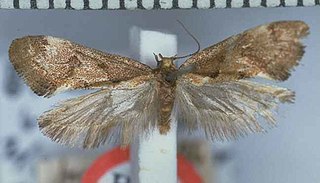
Tingena brachyacma is a species of moth in the family Oecophoridae. It is endemic to New Zealand and has been found in the south of the South Island. This species inhabits open swamps, native forest and scrubland and has been collected amongst Leptospermum. The adults of the species are on the wing in November and December.















